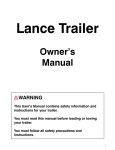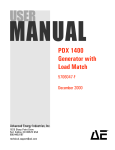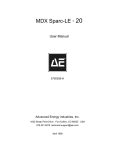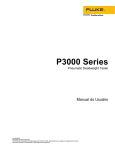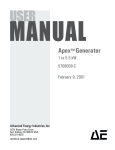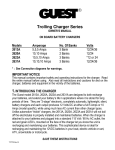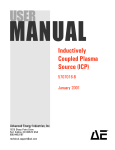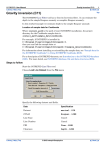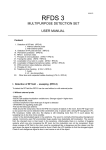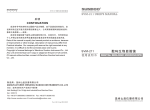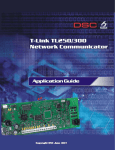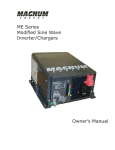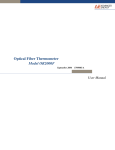Download User Manual
Transcript
User Manual ADVANCED ENERGY® RFDS 2K-2V GENERATOR November 1997 Advanced Energy Industries, Inc. 1625 Sharp Point Drive Fort Collins, Colorado 80525 970.221.4670 [email protected] 5705060-B ADVANCED ENERGYâ WARNING Read this entire manual and all other publications pertaining to the work to be performed before installing, operating, or maintaining this equipment. Practice all plant and product safety instructions and precautions. Failure to follow instructions can cause personal injury and/or property damage. All personnel who work with or who are exposed to this equipment must take precautions to protect themselves against serious or possibly fatal bodily injury. Advanced Energy Industries, Inc., (AE) provides information on its products and associated hazards, but it assumes no responsibility for the after-sale operation of the equipment or the safety practices of the owner or user. This equipment produces or uses potentially lethal highvoltage, high-current, radio frequency (RF) energy. NEVER DEFEAT INTERLOCKS OR GROUNDS. All information herein is subject to periodic updates. Inquiries concerning this manual should be directed to AE. Information provided by AE is believed to be correct and reliable. However, no responsibility is assumed by AE unless otherwise expressly taken. is a registered trademark of Advanced Energy Industries, Inc. Advanced Energy is a registered trademark of Advanced Energy Industries, Inc. Microsweep is a registered trademark of Advanced Energy Industries, Inc. Sparc is a registered trademark of Advanced Energy Industries, Inc. Sparc-le is a registered trademark of Advanced Energy Industries, Inc. Arc-Check is a trademark of Advanced Energy Industries, Inc. Arc-Out is a trademark of Advanced Energy Industries, Inc. Astral is a trademark of Advanced Energy Industries, Inc. Fixed Match is a trademark of Advanced Energy Industries, Inc. GenCal is a trademark of Advanced Energy Industries, Inc. Matchless is a trademark of Advanced Energy Industries, Inc. Pinnacle is a trademark of Advanced Energy Industries, Inc. Sparc-vs is a trademark of Advanced Energy Industries, Inc. Starburst is a trademark of Advanced Energy Industries, Inc. 1997 © Copyright by Advanced Energy Industries Inc. All rights reserved. Without written permission, no part of this manual covered by copyright herein may be reproduced or copied in any form or by any means: graphic, electronic, or mechanical, including photocopying, recording, taping, or information and retrieval systems. Written permission must be granted by: Advanced Energy Industries, Inc. 1625 Sharp Point Drive Fort Collins, Colorado 80525 RFDS 2K-2V GENERATOR Chapter 1. Introduction . . . . . . . . . . . . . . . . . . . . . . . . . . . . . . . . . . . . . . . . . . . . . . . . . . .1-1 Read This Page! . . . . . . . . . . . . . . . . . . . . . . . . . . . . . . . . . . . . . . . . . . . . . . .1-1 Overview of the Manual . . . . . . . . . . . . . . . . . . . . . . . . . . . . . . . . . . . . . . . . 1-1 Interpreting the Manual . . . . . . . . . . . . . . . . . . . . . . . . . . . . . . . . . . . . . . . . . 1-1 Type Conventions . . . . . . . . . . . . . . . . . . . . . . . . . . . . . . . . . . . . . . . . . . . . 1-1 Symbols . . . . . . . . . . . . . . . . . . . . . . . . . . . . . . . . . . . . . . . . . . . . . . . . . . . 1-2 User Safety . . . . . . . . . . . . . . . . . . . . . . . . . . . . . . . . . . . . . . . . . . . . . . . . . . . 1-4 Product Safety and Compliance . . . . . . . . . . . . . . . . . . . . . . . . . . . . . . . . . . . 1-5 Directives . . . . . . . . . . . . . . . . . . . . . . . . . . . . . . . . . . . . . . . . . . . . . . . . . . 1-5 Electromagnetic Compatibility (EMC) . . . . . . . . . . . . . . . . . . . . . . . . . . 1-5 Safety . . . . . . . . . . . . . . . . . . . . . . . . . . . . . . . . . . . . . . . . . . . . . . . . . . . . 1-5 Standards. . . . . . . . . . . . . . . . . . . . . . . . . . . . . . . . . . . . . . . . . . . . . . . . . . . 1-5 Chapter 2. Theory of Operation . . . . . . . . . . . . . . . . . . . . . . . . . . . . . . . . . . . . . . . . . . . . 2-1 General Description . . . . . . . . . . . . . . . . . . . . . . . . . . . . . . . . . . . . . . . . . . . . 2-1 Regulation Mode . . . . . . . . . . . . . . . . . . . . . . . . . . . . . . . . . . . . . . . . . . . . .2-1 Cooling . . . . . . . . . . . . . . . . . . . . . . . . . . . . . . . . . . . . . . . . . . . . . . . . . . . . 2-1 Ambient Operating Temperature . . . . . . . . . . . . . . . . . . . . . . . . . . . . . . . . 2-1 Humidity . . . . . . . . . . . . . . . . . . . . . . . . . . . . . . . . . . . . . . . . . . . . . . . . . . .2-2 Interlock . . . . . . . . . . . . . . . . . . . . . . . . . . . . . . . . . . . . . . . . . . . . . . . . . . . 2-2 Protection . . . . . . . . . . . . . . . . . . . . . . . . . . . . . . . . . . . . . . . . . . . . . . . . . . 2-2 Theory Of Operation . . . . . . . . . . . . . . . . . . . . . . . . . . . . . . . . . . . . . . . . . . . 2-2 Input (1) . . . . . . . . . . . . . . . . . . . . . . . . . . . . . . . . . . . . . . . . . . . . . . . . . .2-3 Auxiliary Supply (2) . . . . . . . . . . . . . . . . . . . . . . . . . . . . . . . . . . . . . . . . .2-3 Inverter (3) . . . . . . . . . . . . . . . . . . . . . . . . . . . . . . . . . . . . . . . . . . . . . . . .2-3 Rf Module (4) . . . . . . . . . . . . . . . . . . . . . . . . . . . . . . . . . . . . . . . . . . . . . .2-3 Driver/exciter (4a) . . . . . . . . . . . . . . . . . . . . . . . . . . . . . . . . . . . . . . . . . .2-4 Power Amplified (4b) . . . . . . . . . . . . . . . . . . . . . . . . . . . . . . . . . . . . . . . .2-4 Output Tank/filter (4c) . . . . . . . . . . . . . . . . . . . . . . . . . . . . . . . . . . . . . . . .-4 Power Measurement System (5) . . . . . . . . . . . . . . . . . . . . . . . . . . . . . . . .2-4 Control and Logic (6) . . . . . . . . . . . . . . . . . . . . . . . . . . . . . . . . . . . . . . . .2-4 Chapter 3. Specifications . . . . . . . . . . . . . . . . . . . . . . . . . . . . . . . . . . . . . . . . . . . . . . . . . .3-1 Physical Specifications . . . . . . . . . . . . . . . . . . . . . . . . . . . . . . . . . . . . . . . . . .3-1 Electrical Specifications . . . . . . . . . . . . . . . . . . . . . . . . . . . . . . . . . . . . . . . . .3-1 Environmental Specifications . . . . . . . . . . . . . . . . . . . . . . . . . . . . . . . . . . . . .3-3 Chapter 4. Connectors, Controls, and Indicators . . . . . . . . . . . . . . . . . . . . . . . . . . . . . .4-1 Connectors and Pins. . . . . . . . . . . . . . . . . . . . . . . . . . . . . . . . . . . . . . . . . . . . .4-1 User Port . . . . . . . . . . . . . . . . . . . . . . . . . . . . . . . . . . . . . . . . . . . . . . . . . . . .4-1 Switches, Controls, and Indicators . . . . . . . . . . . . . . . . . . . . . . . . . . . . . . . . .4-7 5705060-B iii Advanced Energy® Controls And Switches . . . . . . . . . . . . . . . . . . . . . . . . . . . . . . . . . . . . . . . . 4-7 Indicators . . . . . . . . . . . . . . . . . . . . . . . . . . . . . . . . . . . . . . . . . . . . . . . . . . . 4-7 Front Panel . . . . . . . . . . . . . . . . . . . . . . . . . . . . . . . . . . . . . . . . . . . . . . . . . . . 4-8 Rear Panel . . . . . . . . . . . . . . . . . . . . . . . . . . . . . . . . . . . . . . . . . . . . . . . . . . . . 4-8 Chapter 5. Installation And Setup . . . . . . . . . . . . . . . . . . . . . . . . . . . . . . . . . . . . . . . . . . 5-1 Setting Up . . . . . . . . . . . . . . . . . . . . . . . . . . . . . . . . . . . . . . . . . . . . . . . . . . . . 5-1 Unpacking . . . . . . . . . . . . . . . . . . . . . . . . . . . . . . . . . . . . . . . . . . . . . . . . . . 5-1 Grounding . . . . . . . . . . . . . . . . . . . . . . . . . . . . . . . . . . . . . . . . . . . . . . . . . . . 5-1 Spacing Requirements. . . . . . . . . . . . . . . . . . . . . . . . . . . . . . . . . . . . . . . . . . . 5-2 Connecting Cooling Water . . . . . . . . . . . . . . . . . . . . . . . . . . . . . . . . . . . . . . . 5-3 Connecting Input Power . . . . . . . . . . . . . . . . . . . . . . . . . . . . . . . . . . . . . . . . . 5-3 Connecting Output Power . . . . . . . . . . . . . . . . . . . . . . . . . . . . . . . . . . . . . . . 5-3 Chapter 6. Operation . . . . . . . . . . . . . . . . . . . . . . . . . . . . . . . . . . . . . . . . . . . . . . . . . . . . . 6-1 First-time Operation . . . . . . . . . . . . . . . . . . . . . . . . . . . . . . . . . . . . . . . . . . . . 6-1 Start-up . . . . . . . . . . . . . . . . . . . . . . . . . . . . . . . . . . . . . . . . . . . . . . . . . . . . 6-1 Chapter 7. Troubleshooting . . . . . . . . . . . . . . . . . . . . . . . . . . . . . . . . . . . . . . . . . . . . . . . 7-1 Check First . . . . . . . . . . . . . . . . . . . . . . . . . . . . . . . . . . . . . . . . . . . . . . . . . . . 7-1 Power Off Checks . . . . . . . . . . . . . . . . . . . . . . . . . . . . . . . . . . . . . . . . . . . . 7-1 Power On Checks . . . . . . . . . . . . . . . . . . . . . . . . . . . . . . . . . . . . . . . . . . . . 7-1 Fault Indication . . . . . . . . . . . . . . . . . . . . . . . . . . . . . . . . . . . . . . . . . . . . . . . 7-1 Limit Indication . . . . . . . . . . . . . . . . . . . . . . . . . . . . . . . . . . . . . . . . . . . . . . . 7-2 Troubleshooting Guide . . . . . . . . . . . . . . . . . . . . . . . . . . . . . . . . . . . . . . . . . . 7-2 Other Technical Problems . . . . . . . . . . . . . . . . . . . . . . . . . . . . . . . . . . . . . . . 7-4 Returning Units For Repair . . . . . . . . . . . . . . . . . . . . . . . . . . . . . . . . . . . . . 7-4 Warranty Information . . . . . . . . . . . . . . . . . . . . . . . . . . . . . . . . . . . . . . . . . . . 7-5 Warranty Claims . . . . . . . . . . . . . . . . . . . . . . . . . . . . . . . . . . . . . . . . . . . . . 7-5 Authorized Returns . . . . . . . . . . . . . . . . . . . . . . . . . . . . . . . . . . . . . . . . . . . 7-6 Upgrading Units. . . . . . . . . . . . . . . . . . . . . . . . . . . . . . . . . . . . . . . . . . . . . . 7-6 Warranty . . . . . . . . . . . . . . . . . . . . . . . . . . . . . . . . . . . . . . . . . . . . . . . . . . . 7-6 iv 5705060-B RFDS 2K-2V GENERATOR Chapter 1 Introduction 1 Read This Page . . . . . . . . . . . . . . . . . . . . . . . . . . . . . . . . . . . . . . . . . . . . 1-1 Overview of the Manual . . . . . . . . . . . . . . . . . . . . . . . . . . . . . . . . . . . . . 1-1 Interpreting the Manual . . . . . . . . . . . . . . . . . . . . . . . . . . . . . . . . . . . . . 1-1 User Safety . . . . . . . . . . . . . . . . . . . . . . . . . . . . . . . . . . . . . . . . . . . . . . . 1-4 Product Safety and Compliance . . . . . . . . . . . . . . . . . . . . . . . . . . . . . . . 1-5 READ THIS PAGE! We know that some of you want to start the generator now and that you don’t feel you have the time to read the entire manual. Following are sub-sections you need to read in order to get started. Overview of the Manual and Interpreting the Manual are short sections intended to guide you through the manual. Overview of the Manual explains the organization of the manual, so you can more quickly find what you need. Interpreting the Manual explains the type conventions (what it means when a word appears in capitalized italic type, for instance), and what the icons (symbols) mean. OVERVIEW OF THE MANUAL The main table of contents is an outline of the major topics covered in the manual. It contains only the chapter titles and the first heading levels within each chapter, so you can skim it and get an idea of what is contained, without being overwhelmed by several heading levels. When you turn to a chapter, a table of contents lists each sub-heading in the chapter and its page number. INTERPRETING THE MANUAL Type Conventions To help you quickly pick out what is being discussed, the manual presents certain words and phrases in type that are different from the rest of the text. Pin and signal names appear in capitalized italics (RF PWR ON CMD.D). Labels that are on the unit (switches, indicators, etc.) generally appear in boldface capital letters (MODIFY). Exceptions are port names, which simply begin with a capital letter (User port). 5705060-B Introduction 1-1 Advanced Energy® Functions are printed in boldface lowercase letters (analog input filtering). Symbols DANGER: This symbol warns you of imminent physical hazard to you if proper procedures are not followed. WARNING: This symbol calls your attention to a condition or situation that could cause injury to you or damage to equipment. The following symbols appear on labels on your unit. Short circuit protected Protective earth ground General danger (Refer to Manual) CE label 1-2 Introduction 5705060-B RFDS 2K-2V GENERATOR Warning Labels 5705060-B Introduction 1-3 Advanced Energy® Non-Ionizing NRTL GS Label USER SAFETY Do not attempt to install or operate this equipment without having proper training first. Make sure this unit is properly grounded. Ensure all cables are connected and are tight. Verify that input line voltage and current capacity are correct before turning the generator. Use proper ESD precautions. DO NOT BE CARELESS AROUND THIS EQUIPMENT. WARNING: RISK OF DEATH OR BODILY INJURY Disconnect all sources of input power before working on this unit or system. 1-4 Introduction 5705060-B RFDS 2K-2V GENERATOR PRODUCT SAFETY AND COMPLIANCE Directives ELECTROMAGNETIC COMPATIBILITY (EMC) 89/336/EEC EC Council directive on the approximation of the laws of the Member States relating to electromagnetic compatibility (EMC Directive with amendments). 47 CFR Part 18 Code of Federal Regulations—Limits and Methods of Measurement of Radio Interferance Characteristics of Industrial, Scientific, and Medical Equipment. SAFETY 73/23/EEC EC Council directive on the harmonization of the laws of the Member States relating to electrical equipment designed for use within certain voltage limits (LVD - Low Voltage Directive with amendments). Standards This device has been designed to meet the following Safety and EMC standard(s): • EN 50082-2 • EN 50178 • EN 55011 (Class A, Group 2) (CISPR 11) • VDE 0160 • CSA-C22.2 No. 107.1-M91 • UL 1012 This device must be installed and used only in compliance with the standards listed in addition to VDE 0113, EN 60204 (IEC 204), and applicable requirements. For more information, refer to the letter of conformance (US) or declaration of conformity (EU) accompanying the product. 5705060-B Introduction 1-5 Advanced Energy® 1-6 Introduction 5705060-B RFDS 2K-2V GENERATOR Chapter 2 Theory of Operation 2 General Description . . . . . . . . . . . . . . . . . . . . . . . . . . . . . . . . . . . . . . . . 2-1 Theory of Operation . . . . . . . . . . . . . . . . . . . . . . . . . . . . . . . . . . . . . . . . 2-2 GENERAL DESCRIPTION The RFDS 2K-2V is a 13.56 MHz RF generator designed to regulate its output power based on delivered power. The unit is designed to deliver a nominal 2 kW into a 2:1 VSWR load and 1.5 kW into a 3:1 VSWR load. The RFDS 2K-2V has internal protection limits permitting safe and reliable operation into all load conditions. The unit is controlled through a 25-pin analog/digital user port. There is no operator control panel provided on this unit. AC power for the RFDS 2K-2V is supplied from a 4-wire, 3 φ with ground, 208 Vac (nominal) power source. No neutral connection is required. The unit is water cooled with no provisions or requirements for forced air cooling. Regulation Mode The RFDS 2K-2V regulates by delivered power as measured at the output of the generator. Cooling Cooling is to be accomplished by way of water cooling only. The unit must operate normally with inlet water temperatures up to 25°C (77°F). The minimum flow rate required to operate with an inlet water temperature of 25°C (77°F) must be no less than 7.57 liters (2 gallons) per minute. The cooling system must be capable of handling line pressures up to 100 psi (6.9 bars). Ambient Operating Temperature The RFDS 2K-2V operates reliably with an ambient air temperature range of 5° to 40°C. This assumes minimum water flow and maximum water temperature conditions. 5705060-B Theory of Operation 2-1 Advanced Energy® Humidity The RFDS 2K-2V operates in a non-condensing, 15 to 85% relative humidity environment. Critical components and assemblies are conformally coated to prevent damage due to moisture build up. Interlock The RFDS 2K-2V provides connections through its 25-pin User port interface for a single loop-through interlock string. A contact resistance of 3 Ω or less between the interlock pins enables the unit. Protection The RFDS 2K-2V protects itself from damage under the following conditions: • Any unmatched load condition at the unit output. Output power fold-back (limiting) occurs as required by the generator protection circuits. • Excessive internal temperature (may be caused by lack of proper cooling water flow, excessive ambient operating temperature, or other causes). • Any combination of input AC line phase drop out. • Input line brown out (under voltage) or over voltage. THEORY OF OPERATION 2-2 Theory of Operation 5705060-B RFDS 2K-2V GENERATOR Figure 2-1 and the following paragraphs provide a description of the high-level operation of your RFDS 2K-2V generator. AC (1) Input In (3) Inverter (4) RF Module (4A) Driver/Exciter (5) RF Measurement Out System (4B) Power Amplifier (2) Auxiliary Supply Control Interface (4C)Output Tank/Filter (6) Control & Logic Figure 2-1. RFDS 2K-2V block diagram INPUT (1) In the input section, 208 Vac, 3 φ, line voltage is routed through a circuit breaker and line filter to a 3 φ contactor and the input of an auxiliary supply (2). The contactor, when closed, delivers the line voltage to a diode bridge, where it is rectified to 300 Vdc. The 300 Vdc bus is provided to the inverter section (3). AUXILIARY SUPPLY (2) The auxiliary supply provides dc power to control and logic circuits throughout the generator. Its switching design operates at 230 kHz and generates approximately 250 W of power at 30 Vdc, ±15 Vdc, and 5 Vdc. It also supplies limited 24 Vdc and 15 Vdc power to the control connector for external use. INVERTER (3) The inverter provides variable-amplitude dc power to the RF power amplified (4B). It uses MOSFET transistors as switches to convert the 300 Vdc bus from the input section to a variable 0 to 200 Vdc signal. A 0 to 10 Vdc analog signal from the control section (6) regulates the dc voltage. At full rated power, this section must supply up to 4000 W to the power amplifier (4B). 5705060-B Theory of Operation 2-3 Advanced Energy® RF MODULE (4) The RF module converts dc energy from the inverter to 13.56 MHz and efficiently delivers it to a 50 Ω load. It consists of three sections mounted on a single heat sink: the driver/ exciter (4A), the power amplified (4B), and the output tank/filter (4C). The RF module uses a space- and power-efficient design that is made possible by a patented RF amplifier developed at Advanced Energy Industries, Inc. DRIVER/EXCITER (4A) The hybrid driver/ecxciter provides a buffered 13.56 MHz signal capable of driving the power amplifier (4B). It contains three stages of amplifiction. The driver/exciter is designed to drive extremely low impedance loads and is short-circuit protected to prevent damage due to mishandling or failures in succeeding stages. It can provide at least twice the power required to drive the power amplifier to its full-rated output power. POWER AMPLIFIER (4B) The power amplifier (PA) uses the dc power from the inverter (3) to boost the signal from the exciter (4A) to the required output level. The PA consists of two AE proprietary hybrid modules. The efficient operation of this section results in low heat dissipation which allows a compact arrangement of components. The PA has a built-in 65% headroom for reliability when operated into plasma loads. It uses a new class of operation patented by AE. OUTPUT TANK/FILTER (4C) This section removes unwanted harmonics generated by the power amplifier and matches the impedance of the amplifier to a 50 Ω load. The planar photolithographic techniques used in the output tank circuitry eliminate air coils and their associated variability due to operating conditions or manufacturing tolerances. This provides the RFDS 2K-2V generator with extremely stable and consistent operating characteristics. POWER MEASUREMENT SYSTEM (5) This section provides stable, precise, analog signals representing the delivered and reflected power measured at the output connector. The measurement system consists of a microstrip directional coupler, and an RF-to-dc converter. The directional coupler samples the forward and reflected power and has a flat-coupling coefficient that provides accurate power measurement into any load. The RF-to-dc converter provides the linearizer with constant dc voltages proportional to the forward and reflected power, which are stable over wide variations of load impedance and temperature. The measurement system is calibrated using a computerized test station. 2-4 Theory of Operation 5705060-B RFDS 2K-2V GENERATOR CONTROL AND LOGIC (6) The control and logic module accepts analog and digital commands from the operator and processes internal feedback signals to control the generator. It also provides status information to the operator. The control and logic module monitors the delivered power signal from the measurement system and compares it to the requested setpoint. Any resulting error signal is used to adjust the variable 0 to 200 Vdc output of the power inverter (3) and hence the output of the power amplifier (4B). 5705060-B Theory of Operation 2-5 RFDS 2K-2V GENERATOR Chapter 3 Specifications 3 Physical . . . . . . . . . . . . . . . . . . . . . . . . . . . . . . . . . . . . . . . . . . . . . . . . . . 3-1 Electrical . . . . . . . . . . . . . . . . . . . . . . . . . . . . . . . . . . . . . . . . . . . . . . . . . 3-1 Environmental. . . . . . . . . . . . . . . . . . . . . . . . . . . . . . . . . . . . . . . . . . . . . 3-3 PHYSICAL SPECIFICATIONS Table 3-1. Physical Specifications Size 12.5 cm H x 17.8 cm W x 38.1 cm D (4.9 in H x 7 in W x 15 in D) with rubber feet (3M) Weight 11.8 Kg (26 lb) maximum Connector / Cable Specifications RF Output Connector HN Female AC Power Input 3 meter, 4-wire, 10 AWG with Marinco 3015P Crimp, or equivalent User Port Connector 25-pin, subminiature-D, female Coolant Connectors 0.25 in female NPT ELECTRICAL SPECIFICATIONS Table 3-2. Electrical Specifications Input Power Specifications Line Voltage 187 to 229 Vac (208 Vac nominal), 3 φ with ground Line Frequency 50 to 60 Hz Line Current 15 A /φ maximum (at full rated RF output power) Overcurrent Protection 20 A circuit breaker Output Power 2000 W nominal into loads of ≤2:1 VSWR; 1500 W nominal into loads of ≤3:1 VSWR (See Figure 3-1 for output power limits) Regulation ±1% of setpoint or ±3 W (whichever is greater) into a 50 Ω load Frequency 13.56 MHz, ±0.005% Response Time < 20 ms rise and fall time from RF on or RF off Load Mismatch The generator operates continuously into any load mismatch without failure. 5705060-B Specifications 3-1 Advanced Energy® Table 3-2. Electrical Specifications Harmonics At full rated output, all harmonics are ≤-55 dBc below the RF output signal when operated into a 50 Ω, nonreactive load. Spurious Signals Non-harmonic spurious and noise signals are ≤-40 dBc Transient Response Less than 0.1% change in output power for a 10% change in the ac line voltage RFG 2000-2V Power Derating Delivered Power - Watts 2500 Maximum Power 180 Degree Phase Angle 2000 1500 1000 Guaranteed Power All Phase Angles 500 0 0 0.1 0.2 0.3 0.4 0.5 0.6 0.7 0.8 0.9 1 Magnitude of the Reflection Coefficient Figure 3-1. RFDS 2K-2V Power Derating Curve 3-2 Specifications 5705060-B RFDS 2K-2V GENERATOR ENVIRONMENTAL SPECIFICATIONS Table 3-3. Climatic Conditions: Temperature Relative Humidity Class 3K3 Class 3K3 Operating Storage Transportation Air Pressure Class 3K3, (note 1) +5°C to +40°C 5% to 85% +41°F to 104°F 1 g/m3 to 25 g/m3 860 mBar to 1060 mBar Class 1K4 Class 1K3 Class 1K4 -25°C to +55°C 5% to 95% 3 86 kPa to 106 kPa 86 kPa to 106 kPa 3 -13°F to 131°F 1 g/m to 29 g/m Class 2K3 Class 2K3 Class 2K3 -25°C to +55°C (note 4) 95% (note 2) 70 kPa to 106 kPa 60 -13°F to 131°F g/m3 (note 3) 860 mBar to 1060 mBar 700 mBar to 1060 mBar Note 1: Non-Condensing Note 2: Maximum relative humidity when the unit temperature slowly increases, or when the unit temperature directly increases from -25° to +30°C Note 3: Maximum absolute humidity when the unit temperature directly decreases from +70° to +15°C. Note 4: The unit may be subjected to a maximum temperature of +70°C (+158°F) if the cumulative exposure does not exceed 24 hours. Table 3-4. Environmental Specifications Coolant Medium Requirements Temperature +15°C to +30°C (+59°F to +86°F) inlet temperature Flow Rate 7.57 lpm (2 gpm) minimum 5705060-B Specifications 3-3 Advanced Energy® Table 3-4. Environmental Specifications Pressure 100 psi maximum inlet pressure Contaminates The following specifications are recommended for the water used to cool the RFDS 2K-2V: • pH between 7 and 9 • Total chlorine < 20 ppm • Total nitrate < 10 ppm • Total sulfate < 100 ppm • Total dissolved solids < 250 ppm • Total hardness expressed as calcium carbonate equivalent less than 250 ppm • Specific resistivity of 2500 Ω/cm or higher at 25°C • Total dissolved solids (TDS) as estimated by the following: TDS ≤ 3-4 640,000 specific resistivity (Ω/cm) Specifications 5705060-B RFDS 2K-2V GENERATOR Chapter 4 Connectors, Controls, and Indicators 4 Connectors and Pins . . . . . . . . . . . . . . . . . . . . . . . . . . . . . . . . . . . . . . . . 4-1 Switches and Indicators . . . . . . . . . . . . . . . . . . . . . . . . . . . . . . . . . . . . . 4-7 Front Panel . . . . . . . . . . . . . . . . . . . . . . . . . . . . . . . . . . . . . . . . . . . . . . . 4-8 Rear Panel . . . . . . . . . . . . . . . . . . . . . . . . . . . . . . . . . . . . . . . . . . . . . . . . 4-8 CONNECTORS AND PINS User Port User Port 25-pin, subminiature-D, shielded, female Signal Characteristics Unless othrwise specified, all analog signals are 0 to 10 V, all digital input signals drive opto-coupler LEDs (4 to 30 V required for LED turn-on), and all digital output signals are opto-coupled (open-collector signals with return lines nonreferenced to ground, 45 V dc and 12 mA maximum). 5705060-B Connectors, Controls, and Indicators 4-1 Advanced Energy® Table 4-1. User Port Pin Description Table Signal Pin Return Pin Signal Name Signal Type Description 2 15 REFLECTED PWR MONITOR.A Analog Output This 0 to 10 Vdc signal monitors the reflected power as measured at the output of the generator. It is scaled to represent 0 to 2500 W (1 V = 250 W). 3 16 DELIVERED PWR MONITOR.A Analog Output This 0 to 10 Vdc signal monitors the level of delivered power as measured at the output of the generator. It is scaled to represent 0 to 2000 W (1 V = 200 W). Accuracy is ±1% of setpoint or 3 W, whichever is greater, into a 50 Ω load. The impedance between pin 3 and pin 16 should be no less than 2 Ω. 4 17 RF PWR ON.D Digital Input This signal is connected to the anode of an opto-coupler LED through a 1 kΩ, 1 W resistor (the cathode is connected to pin 17). RF power is enabled when a voltage of 4 to 30 Vdc is applied across pins 4 and 17. RF power is disabled when the voltage across pins 4 and 17 is less than 1.5 Vdc. 5 18 SETPOINT.A Analog Input This 0 to 10 Vdc signal controls the level of delivered power. It is scaled to represent 0 to 2000 W (1 V = 200 W). When operating into a 50 Ω, non-reactive load, the generator’s accuracy is ±1% of the level between 300 and 2000 W. Between 30 and 300 W, the accuracy is ±3 W. 6 19 24 VOLT DC 24 Vdc 24 Vdc regulated output, 50 mA maximum current 8 4-2 RESERVED Reserved for future use Connectors, Controls, and Indicators 5705060-B RFDS 2K-2V GENERATOR Table 4-1. User Port Pin Description Table Signal Pin Return Pin Signal Name 10 23 INTERLOCK Pins 10 and 23 form a system interlock loop. These pins must be connected together with less than 3 Ω series resistance for the main contactor to close, as well as a coaxial connector properly installed on the output RF connector, in order to provide power to the inverter. An open interlock (approximately 5 Ω) will not allow the RF to be turned on. If the interlock is opened when RF STATUS.D is active, RF turns off, the 3φ contactor opens, and the rear panel AC ON and RF ON LEDs go out. To restore RF power, it is only necessary to satisfy the interlock. It takes approximately 0.5 s to restore RF power after the interlock is satisfied. As the series resistance between pins 23 and 10 increases, the time needed to engage the interlock also increases. A resistance greater than 5 Ω will not satisfy the interlock. RESERVED Reserved for future use 12 13 5705060-B 19 15 VOLT DC Signal Type 15 Vdc Description 15 volt regulated output, 50 mA maximum current Connectors, Controls, and Indicators 4-3 Advanced Energy® Table 4-1. User Port Pin Description Table 4-4 Signal Pin Return Pin Signal Name Signal Type Description 14 1 SETPOINT STATUS.D Digital Output This signal is connected to the collector terminal of an optocoupled NPN tranisistor (the emitter terminal is connected to pin 1). A low impedance between pins 14 and 1 indicates that the generator cannot produce the power requested by the SETPOINT.S control voltage between pins 5 and 18. The rear panel ALARM LED lights when this condition exists. The maximum current through pins 14 and 1 is limited to 12 mA, the maximum differential voltage is limited to 45 Vdc, the minimum differential voltage is -0.5 Vdc, and the maximum common mode voltage between pins 14 and 1 to chassis ground is ±50 V. 19 6 and 13 POWER SUPPLY RETURN Reference This signal is a dedicated ground that returns to the internal system and chassis ground, and finally to protective-earth ground. 20 7 RF STATUS.D Digital output This signal is connected to the collector terminal of an optocoupled NPN transistor (the emitter terminal is connected to pin 7). A low impedance between pins 20 and 7 indicates that the RF output is enabled and also lights the RF ON LED. The maximum current through pins 20 and 7 is limited to 12 mA; the maximum differential voltage is limited to 45 Vdc; the minimum differential voltage is -0.5 Vdc; the maximum common mode voltage between pins 20 and 7 to chassis ground is ±50 V. Connectors, Controls, and Indicators 5705060-B RFDS 2K-2V GENERATOR Table 4-1. User Port Pin Description Table Signal Pin Return Pin 21 Signal Name 9 OVERTEMP SHUTDOWN .D 23 10 INTERLOCK Description This pin is tied to the same chassis ground reference that pin 19 is connected to. CHASSIS GROUND 22 5705060-B Signal Type Digital Output This signal is connected to the collector terminal of an optocoupled NPN transistor (the emitter terminal is connected to pin 9). A low impedance between pins 22 and 9 indicates that the generator has turned off RF power because the internal temperature is too high and also turns on the ALARM LED. An overtemperature fault will not allow RF to be turned on. If the overtemperature fault occurs while the RF STATUS.D signal is active, RF is turned off. Check the cooling water flow and temperature as well as consulting Chapter 7 to assist you in clearing this fault. Note: If the temperature in the unit continues to rise, a second thermal limit may be reached at which point all power to the unit is shut off. Refer to pin 10 for a description. Connectors, Controls, and Indicators 4-5 Advanced Energy® Table 4-1. User Port Pin Description Table Signal Pin Return Pin Signal Name Signal Type Description 24 11 AC ON.D Digital Output This signal is connected to the collector terminal of an optocoupled NPN transistor (the emitter terminal is connected to pin 11). A low impedance state between pins 24 and 11 indicates that ac power has been applied, all three phases are present, the interlock is satisfied, the main contactor is closed, and the ac voltage to the main power inverter is within the specified voltage range. The AC ON LED also lights. The maximum current through pins 24 and 11 is limited to 12 mA; the maximum differential voltage is limited to 45 Vdc; the minimum differential voltage is -0.5 Vdc; the maximum common mode voltage between pins 24 and 11 to chassis ground is ±50 V. 25 RESERVED RFDS 2K-2V 0 to 10 Vdc + Reserved for future use 100 K 100 K 100 K 100 K Figure 4-1. Differential analog inputs 4-6 Connectors, Controls, and Indicators 5705060-B RFDS 2K-2V GENERATOR RFDS 2K-2V R > 20 K R < 500 K 0 to 10 Vdc Ground reference at receiving end necessary Figure 4-2. Differential analog outputs 1 K, 1 W RFDS 2K-2V 4 to 30 Vdc ON <1.5 Vdc OFF Figure 4-3. Digital inputs (optically isolated) RFDS 2K-2V 470 Ω Signal 5 Vdc ON <1.5 Vdc OFF Max current = 12 mA Max Voltage = 45 V Max Reverse Voltage = -.5 V Return Figure 4-4. Digital outputs (optically isolated) SWITCHES, CONTROLS, AND INDICATORS Controls and Switches The RFDS 2K-2V does not have an operator control panel. All power, control, and water connections are made at the front of the unit. Indicators Three status LEDs are visible from the rear of the unit for monitoring the following functions. 5705060-B Connectors, Controls, and Indicators 4-7 Advanced Energy® Table 4-2. Status LEDs AC ON This green LED indicates that ac power is available within the unit, all three phases are present, the main contactor is energized, the ac voltage to the inverter section is within the allowable voltage range, and all interlock criteria are satisfied. The unit is ready to supply RF output power. RF ON This green LED indicates that RF power is on. Depending on the selected setpoint value, RF power may or may not be present at the output connector. ALARM This green LED indicates that the unit is unable to satisfy the requested setpoint power due to some limit or alarm condition in the generator. Some of the conditions that can cause an alarm are high VSWR, over-temperature, and internal power limits. FRONT PANEL The front panel is a blank panel. Everything required for operation is on the rear panel. REAR PANEL Figure 4-5. Rear panel drawing 4-8 Connectors, Controls, and Indicators 5705060-B RFDS 2K-2V GENERATOR Chapter 5 Installation And Setup 5 Setting Up . . . . . . . . . . . . . . . . . . . . . . . . . . . . . . . . . . . . . . . . . . . . . . . . 5-1 Grounding . . . . . . . . . . . . . . . . . . . . . . . . . . . . . . . . . . . . . . . . . . . . . . . . 5-1 Spacing Requirements . . . . . . . . . . . . . . . . . . . . . . . . . . . . . . . . . . . . . . 5-2 Connecting Cooling Water . . . . . . . . . . . . . . . . . . . . . . . . . . . . . . . . . . . 5-3 Connecting Input Power . . . . . . . . . . . . . . . . . . . . . . . . . . . . . . . . . . . . . 5-3 Connecting Output Power. . . . . . . . . . . . . . . . . . . . . . . . . . . . . . . . . . . . 5-3 SETTING UP Unpacking Unpack and inspect your generator carefully. Check for obvious physical damage. If no damage is apparent, proceed with the unit connections. If you do see signs of shipping damage, contact Advanced Energy Industries, Inc., and the carrier immediately. Save the shipping container for submitting necessary claims to the carrier. GROUNDING The RFDS 2K-2V provides an RFI ground mounting lug. A suitable chassis ground connection made to this mounting lug prevents or minimizes radio frequency interference. Note: For more information about grounding, refer to AE Application Notes titled Grounding p/n 5600031A. 5705060-B Installation And Setup 5-1 Advanced Energy® SPACING REQUIREMENTS 5-2 Installation And Setup 5705060-B RFDS 2K-2V GENERATOR CONNECTING COOLING WATER This generator is water cooled. Do not operate it until water is connected and the cooling requirements are met. WARNING: If you connect the cooling water on multiple units in series, be sure that input water temperature to all units is less than the maximum input water temperature. Connect the input and output water connections and tighten securely. Turn on the water and ensure that there are no leaks. Be sure that the flow rate and temperature are within the minimum specifications required to operate your RFDS 2K-2V generator. Note: Keep the water-cooling system running as long as the rear circuit breaker is on. Overheating can occur even if RF is not being produced, because the auxiliary power supply is also water-cooled. CONNECTING INPUT POWER DANGER: Before making any input line power connection, turn off building circuit breakers supplying input power to the RFDS 2K-2V. Also, ensure that the circuit breakers on the rear panel are in the OFF position. Check to be sure the input power is within the specifications shown in Chapter 3. Insert the twist-lock Hubbel connector from the generator into the source power and twist the connector to secure. CONNECTING OUTPUT POWER WARNING: RISK OF DEATH OR BODILY INJURY Disconnect all sources of input power before working on this unit or anything connected to it. Be sure that the input power is turned off at the circuit breakers on the generator. Install the output power cable connector. After tightening the connector, install the locking bracket and tighten the captive screw to secure the bracket and connector. 5705060-B Installation And Setup 5-3 Advanced Energy® 5-4 Installation And Setup 5705060-B RFDS 2K-2V GENERATOR Chapter 6 Operation 6 First-Time Operation. . . . . . . . . . . . . . . . . . . . . . . . . . . . . . . . . . . . . . . . 6-1 FIRST-TIME OPERATION Start-up Before doing anything further, be sure the setup of the RFDS 2K-2V is completed, including the installation of any termination plugs that are required. DANGER: The RFDS 2K-2V can operate without being hooked up to either a chamber or a dummy load. You are exposed to high voltage output from the unit if you do not hook the output to either a dummy load or a chamber. Note: If using a dummy load, connect the RFDS 2K-2V to it with a RG-393 cable and an appropriate load. If you are going to connect the generator to your chamber be sure to satisfy all chamber conditions for operation. The following steps will aid you in setting up your generator initially. 1. Make sure the power in, power out, and User port connectors are installed. 2. Turn on the source power circuit breakers 3. Turn on the generator power circuit breakers. The AC ON LED should come on. 4. Select the proper operation mode and power level through the User port. When the proper power is being produced, the RF ON LED should come on. 5705060-B Operation 6-1 Advanced Energy® 6-2 Operation 5705060-B RFDS 2-2V GENERATOR Chapter 7 Troubleshooting 7 Check First . . . . . . . . . . . . . . . . . . . . . . . . . . . . . . . . . . . . . . . . . . . . . . . 7-1 Fault Indication . . . . . . . . . . . . . . . . . . . . . . . . . . . . . . . . . . . . . . . . . . . . 7-1 Limit Indication . . . . . . . . . . . . . . . . . . . . . . . . . . . . . . . . . . . . . . . . . . . 7-2 Troubleshooting Guide . . . . . . . . . . . . . . . . . . . . . . . . . . . . . . . . . . . . . . 7-2 Other Technical Problems. . . . . . . . . . . . . . . . . . . . . . . . . . . . . . . . . . . . 7-4 Warranty Information . . . . . . . . . . . . . . . . . . . . . . . . . . . . . . . . . . . . . . . 7-5 CHECK FIRST Power Off Checks 1. Check for visible damage on the unit, cables, and connectors. 2. Check to ensure that all connectors are installed correctly and tightly fastened. 3. Check input power to be sure that it is present and meets specifications. 4. Check ground connections and ensure that they are adequate and secure. Power On Checks 1. Check input power connection to ensure the proper power is being supplied the unit. 2. Check LEDs and determine that the proper ones are lit. FAULT INDICATION The RFDS 2K-2V generator has three thermal sensors to protect its circuitry and to alert you to overtemperature conditions within the generator. Two of these sensors, when tripped, result in a partial shutdown of the generator. If either of these sensors activates, the RF power is turned off, the RF ON LED goes out, and the ALARM LED lights to indicate that a problem exists. Additionally, the OVERTEMP signal in the user interface (pins 22 and 9) activate to alert the system to the condition. After the unit cools down, this alarm condition may be reset by toggling the RF PWR ON command (pins 4 and 17). During this type of overtemperature alarm, the SETPOINT STATUS signal (pins 14 and 1) do not go active because the RF power is disabled. 5705060-B Troubleshooting 7-1 Advanced Energy® If the third temperature sensor is tripped, the generator is completely shut down to protect its critical circuits. When this fault occurs, the ac circuit breaker remains on but none of the internal power circuits are active. The generator must be allowed to cool down and then the circuit breaker must be toggled to restore operation. Because of the nature and locations of the three temperature sensors, it is possible that this shutdown sensor may trip before the other two sensors. If this happens, no LED or system warning is given because all power in the generator is disabled. Overtemperature conditions are usually the result of cooling water problems. If an overtemperature fault occurs, check to make sure that the minimum water flow requirement is being met and that the maximum inlet water temperature has not been exceeded. LIMIT INDICATION The ALARM LED lights whenever the generator cannot achieve the setpoint power level. This condition is also reported through the remote interface (pins 1 and 14). Limits are nonlatching; they do not shut off power and will reset once the condition causing the alarm clears. Several possible conditions can trigger the alarm condition, including: • external load conditions resulting in high VSWR. This condition may indicate a problem in the chamber or that the load match between the generator and the load is not operating properly. This may also cause the following conditions. • maximum dissipation allowd within the power amplified section. • internal overvoltage at the main supply rail or the power amplified terminals. • internal maximum current limit. TROUBLESHOOTING GUIDE OPERATING CONDITIONS Signal/LED Signal Status/LED State Normal Operation High VSWR Loads* Overtemperature* SETPOINT STATUS.D Not active. An open circuit (high impedance) between pins 1 & 14 indicates the generator is producing the requested setpoint. Active. A low impedance between pins 1 & 14 indicates the generator is not producing the requested setpoint. Not active. An open circuit exists between pins 1 & 14. REFLECTED PWR MONITOR.A Analog voltage between pins 2 & 15 is 0 to 10V, indicating 0 to 2500W of reflected power (1V=250W). Analog voltage between pins 2 & 15 is > 4V, indicating reflected power is greater than 1000W. VSWR of the load exceeded the operating parameters of the generator. Analog voltage between pins & 15 is 0 V, indicating 0 W reflected power. 7-2 Troubleshooting 2 5705060-B RFDS 2K-2V GENERATOR OPERATING CONDITIONS Signal/LED Signal Status/LED State Normal Operation High VSWR Loads* Overtemperature* DELIVERED PWR MONITOR.A Analog voltage between pins 3 & 16 is 0 to 10V, Indicating delivered power level is 0 to 2000W (1V=200W). Analog voltage between pin 3 & 16 is > 2V, indicating delivered power level of 500W or greater. Analog voltage between pins 3 & 16 is > 2V, indicating delivered power level of 500W or greater. RF STATUS.D Active. Low impedance between pins 7 & 20 indicates RF output enabled. Active. Low impedance between pins 7 & 20 indicates RF output enabled. Inactive. A high impedance between pins 7 & 20 indicates RF output is disabled. OVERTEMP.D Not Active. Open circuit (high impedance) between pins 9 and 22 indicates normal temperature. Not Active. Open circuit (high Impedance) between pins 9 and 22 indicates normal temperature. Active. A low impedance between pins 9 and 22 indicates the internal temperature of the generator has exceeded its safe operating temperature. AC ON.D Active. A low impedance between pins 11 & 24 indicates (1) ac input voltage is on, (2) interlocks are satisfied and, (3) ac power is applied to main switching power supply and is within specifications. Active. A low impedance between pins 11 & 24 indicates ac input voltage is on, interlocks are satisfied and ac power is applied to main switching power supply. Active. A low impedance between pins 11 & 24 indicates ac input voltage is on. AC ON LED lit lit lit RF ON LED lit lit not lit ALARM LED not lit lit lit 5705060-B Troubleshooting 7-3 Advanced Energy® OPERATING CONDITIONS Signal/LED Signal Status/LED State Normal Operation CHECK High VSWR Loads* Overtemperature* *If the unit cannot achieve the requested setpoint power due to mismatched loads. *If the unit has shut off RF power due to a high temperature condition but the generator has not completely shut down. Verify the power setpoint for the resulting VSWR, or reflection coefficient is within the limits of the power derating curve. Check for proper water flow and temperature (2 gpm minimum at 25°C maximum). When the internal temperature is brought back to its operating range, the overtemperature condition can be cleared. You must toggle pin 4 low and then high to turn RF output back on. A second overtemperature fault latches the auxiliary supply in the generator completely off. This latching occurs when either no water or inadequate water is flowing in the generator and the system is unattended. After the generator has cooled off, reset the circuit breaker to clear this fault. OTHER TECHNICAL PROBLEMS For technical support contact: Advanced Energy Industries, Inc. Customer Support 1625 Sharp Point Drive Fort Collins, CO 80525 Phone: 970-221-4670 Fax: 970-221-5583 Email: [email protected] Returning Units for Repair Before returning any product for repair and/or adjustment, FIRST, FOLLOW ALL TROUBLESHOOTING PROCEDURES. If, after following these procedures you still have a problem or if the procedure instructs you to, call AE Customer Service and discuss the problem with a representative. Be prepared to give the serial number of the unit and the reason 7-4 Troubleshooting 5705060-B RFDS 2K-2V GENERATOR for the proposed return. This cousultation call allows Customer Service to determine whether the problem can be corrected in the field or if the unit needs to be returned. Such technical consultation is always available at no charge. If you return a unit without first getting authorization from Customer Service and that unit is found to be functional, you will be charged a re-test and calibration fee plus shipping charges. To ensure years of dependable service, Advanced Energy®products are thoroughly tested and designed to be among the most reliable and highest quality systems available worldwide. All parts and labor carry our standard 18-month warranty. If you have any other questions, please call an AE office at: Advanced Energy Industries, Inc. Phone: 970-221-0108 World Headquarters Fax: 970-221-5583 1625 Sharp Point Drive Fort Collins, CO 80525, USA Advanced Energy Industries, Inc. Phone: 512-719-3939 8403 Cross Park Drive, Suite 2D Fax: 512-719-4319 Austin, TX 78754, USA Advanced Energy Industries, Inc. Phone: 408-263-8784 491 Montague Expressway Fax: 408-263-8992 Milpitas, CA 95035, USA Advanced Energy Industries, Inc. Phone: 508-371-1381 228 Oak Hill Circle Fax: 508-371-0569 Concord, MA 01742, USA Advanced Energy Industries, GmbH Phone: 49-711-77927-0 Raiffeisensstrasse 32 Fax: 49-711-7778700 70794 Filderstadt (Bonlanden) Germany Advanced Energy Industries, Japan KK Phone: 81-3-32351511 TOWA Edogawabashi Fax: 81-3-32353580 Building 347 Yamabuki-cho Shinjuku-ku, Tokyo, Japan Advanced Energy Industries, United Kingdom Phone: 44-1869-321622 Fax: 44-1869-325004 Suite 412, Market Court Victoria Road Bichester, Oxon OX6 7QB UK 5705060-B Troubleshooting 7-5 Advanced Energy® WARRANTY INFORMATION Warranty Claims Advanced Energyâ products are warranted to be free from failures due to defects in material and workmanship for 12 months after they are shipped from the factory (please see warranty statement, below, for details). In order to claim shipping or handling damage, you must inspect the delivered goods and report such damage to AE within 30 days of your receipt of the goods. Please note that failing to report any damage within this period is the same as acknowledging that the goods were received undamaged. For a warranty claim to be valid, it must: • be made within the applicable warranty period, • include the product serial number and a full description of the circumstances giving rise to the claim, • have been assigned a return authorization number (see below) by AE Customer Service. All warranty work will be performed at an authorized AE service center (see list of contacts at the front of the manual). You are responsible for obtaining authorization (see details below) to return any defective units, prepaying the freight costs, and ensuring that the units are returned to an authorized AE service center. AE will return the repaired unit (freight prepaid) to you by second-day air shipment (or ground carrier for local returns); repair parts and labor will be provided free of charge. Whoever ships the unit (either you or AE) is responsible for properly packaging and adequately insuring the unit. Authorized Returns Before returning any product for repair and/or adjustment, call AE Customer Service and discuss the problem with them. Be prepared to give them the serial number of the unit and the reason for the proposed return. This consultation call will allow Customer Service to determine if the unit must actually be returned for the problem to be corrected. Such technical consultation is always available at no charge. Units that are returned without authorization from AE Customer Service and that are found to be functional will not be covered under the warranty (see warranty statement, below). That is, you will have to pay a retest and calibration fee, and all shipping charges. Upgrading Units AE's products are continually changing as ways to improve them are discovered. AE is happy to upgrade older units so that they reflect recent improvements. The fee for upgrading a unit will be a percentage of the current list price, based on the age of the 7-6 Troubleshooting 5705060-B RFDS 2K-2V GENERATOR unit. Such an upgraded unit will carry a 6-month warranty (which will be added to any time remaining on the original warranty). Contact Customer Service for specifics on getting an older unit upgraded to the current revision level. Warranty The seller makes no express or implied warranty that the goods are merchantable or fit for any particular purpose except as specifically stated in printed AE specifications. The sole responsibility of the Seller shall be that it will manufacture the goods in accordance with its published specifications and that the goods will be free from defects in material and workmanship. The seller's liability for breach of an expressed warranty shall exist only if the goods are installed, started in operation, and tested in conformity with the seller's published instructions. The seller expressly excludes any warranty whatsoever concerning goods that have been subject to misuse, negligence, or accident, or that have been altered or repaired by anyone other than the seller or the seller's duly authorized agent. This warranty is expressly made in lieu of any and all other warranties, express or implied, unless otherwise agreed to in writing. The warranty period is 12 months after the date the goods are shipped from AE. In all cases, the seller has sole responsibility for determining the cause and nature of the failure, and the seller's determination with regard thereto shall be final. 5705060-B Troubleshooting 7-7 RFDS 2K-2V GENERATOR Numerics H 73/23/EEC 1-4 89/336/EEC 1-4 harmonics 3-2 humidity 2-2 A I ac power input 3-1 ambient operating temperature 2-1 authorized returns 7-6 auxiliary supply (2) 2-3 indicators 4-7 indicators 4-7 input (1) 2-3 input power specifications 3-1 installation and setup 5-1 interlock 2-2 interpreting the manual 1-1 inverter (3) 2-3 C check first 7-1 climatic conditions 3-3 connecting cooling water 5-3 connecting input power 5-3 connecting output power 5-3 connector / cable specifications 3-1 connectors and pins 4-1 connectors, controls, and indicators 4-1 control and logic (6) 2-4 controls 4-7 controls and switches 4-7 coolant connectors 3-1 coolant contaminates 3-4 coolant flow rate 3-3 coolant pressure 3-4 coolant requirements 3-3 coolant temperature 3-3 cooling 2-1 D directives 1-4 driver/exciter (4a) 2-4 E electrical specifications 3-1 electromagnetic compatibility (emc) 1-4 enhanced operation 6-2 environmental specifications 3-3 F fault indication 7-1 first-time operation 6-1 frequency 3-1 front panel 4-8 G general description 2-1 grounding 5-1 5705060-B L limit indication 7-2 line current 3-1 line frequency 3-1 line voltage 3-1 load mismatch 3-1 O operation 6-1 other technical problems 7-4 output CEX/Drive port 4-7 output power 3-1 output tank/filter (4c) 2-4 overcurrent protection 3-1 overview of the manual 1-1 P physical specifications 3-1 power amplified (4b) 2-4 power measurement system (5) 2-4 power off checks 7-1 power on checks 7-1 product safety and compliance 1-4 protection 2-2 R read this page! 1-1 rear panel drawing 4-8 regulation 3-1 response time 3-1 returning units for repair 7-4 RF module (4) 2-3 RF output connector 3-1 RFDS 2K-2V power derating curve 3-2 Index-i Advanced Energy® S safety 1-4 serial host port 4-7 setting up 5-1 size 3-1 spacing requirements 5-2 specifications 3-1 spurious signals 3-2 standards 1-4 start-up 6-1 switches 4-7 symbols 1-2 T theory of operation 2-1 theory of operation 2-2 transient response 3-2 troubleshooting 7-1 troubleshooting fault tree 7-2 troubleshooting guide 7-2 troubleshooting table 7-2 type 1-1 type conventions 1-1 U unpacking 5-1 upgrading units 7-6 user port 4-1 user port connector 3-1 user port pin description table 4-2 user safety 1-4 W warranty 7-6 warranty claims 7-5 warranty information 7-5 weight 3-1 Index-ii 5705060-B











































